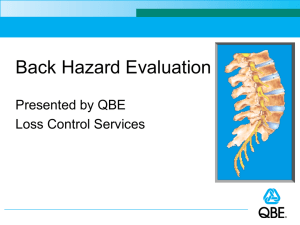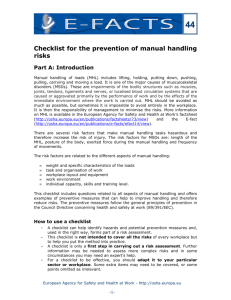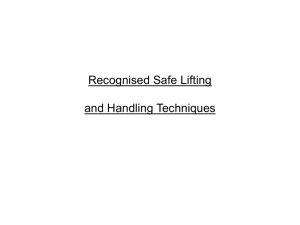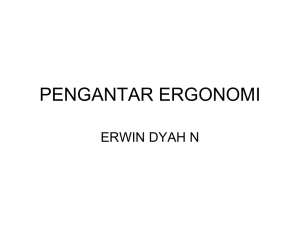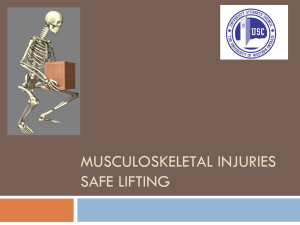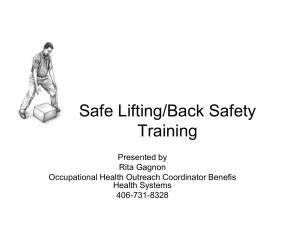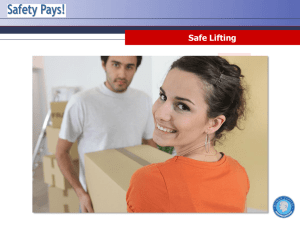Managing Ergonomic Improvements for MMH
advertisement
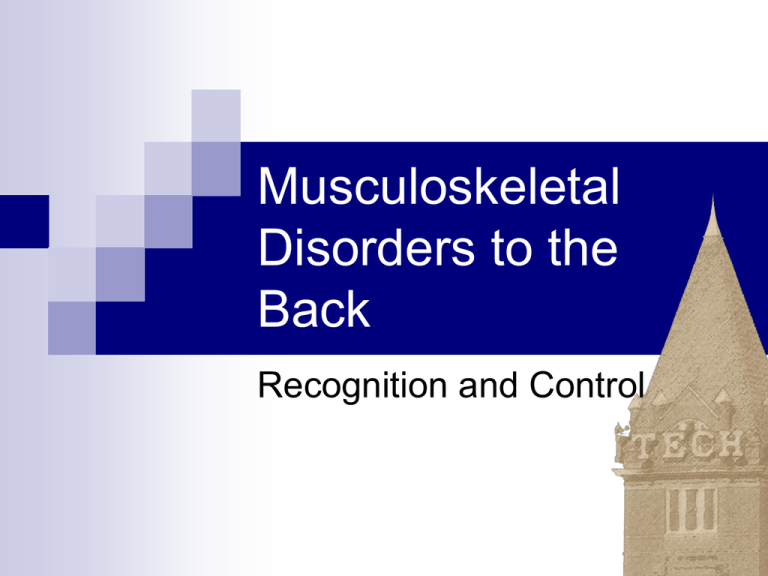
Musculoskeletal Disorders to the Back Recognition and Control Manual Materials Handling Lifting/Lowering Pushing/Pulling Carrying Weights and Forces Frequency of activities Load Center of Gravity Work Related Low Back Pain (LBP) Overexertion was claimed as the cause of LBP by over 60% of LBP patients Two Thirds of Overexertion claims involved lifting One fifth of Overexertion claims involved pushing or pulling loads MSD Injuries from Lifting 30% of Shoulder WMSDs 43% of Back WMSDs 22% of Elbow WMSDs 13% of Hand/Wrist WMSDs Source: SHARP technical report No. 40-6-2002 Evidence for Causal Relationship Between Physical Work Factors and Back-Related MSDs Strong Evidence Evidence Insufficient Evidence Risk Factor Lifting/Forceful Movement X Awkward Posture X Heavy Physical Work X Whole Body Vibration Static Work Posture X X Common Risk Factors for Back MSDs • Force • Frequency • Posture • Duration • Environment • Vibration Back Injury Risk Factor Examples Awkward Postures o o o o Bending Twisting Reaching, etc. Back Injury Risk Factor Examples o Lifting/Forceful Movements o o o o o Weight of load Location (position of load w.r.t. worker) Frequency Stability Coupling Back Injury Risk Factor Examples High Frequency and Lifting Overhead 9 Back Injury Risk Factor Examples Lifting or Lowering Floor Level Lifting above Shoulder Height Look for Clues – Use Assessment Tools o Sample Checklists o o General Checklists o Kodak Ergonomics Checklist for Material Handling o NIOSH Manual Material Handling Checklist Risk Factor Checklists o Hazard Evaluation Checklist for Lifting, Carrying, Pushing or Pulling (T.R. Waters) o Washington Awkward Postures Checklist o REBA – Trunk/Legs o Analysis Tools o Websites Look for Clues – General Checklists Kodak’s Ergonomic Checklist for Material Handling Source: Kodak’s Ergonomic Design for People at Work, as adapted in NIOSH 2007-131 Kodak’s Ergonomics Checklist for Material Handling Condition REPETITION High-speed process line or work presentation rates Similar motions every few seconds Observed signs of fatigue WORKSTATION DESIGN Work surface too high or low Location of materials promotes reaching Angle/orientation of containers promotes non-neutral positions Spacing between adjacent transfer surfaces promotes twisting Obstructions prevent direct access to load/unload points Obstacles on floor prevent a clear path of travel Floor surfaces are uneven, slippery, or sloping Hoists or other power lifting devices are needed but not available X if a Concern Comments Kodak’s Ergonomics Checklist for Material Handling, cont. LIFTING AND LOWERING Heavy objects need to be handled Handling bulky or diffi cult-to-grasp objects Handling above the shoulders or below the knees Lifting to the side or unbalanced lifting Placing objects accurately/precisely Sudden, jerky movements during handling One-handed lifting Long-duration exertions (static work) PUSHING/PULLING/CARRYING Forceful pushing/pulling of carts or equipment required Brakes for stopping hand carts/handling aids are needed but not available Carts or equipment design promotes non- neutral postures Long-distance carrying (carts not available) Kodak’s Ergonomics Checklist for Material Handling, cont. CONTAINERS/MATERIALS Lack adequate handles or gripping surfaces Are unbalanced, unstable, or contents shift Obstructs leg movement when being carried OTHER Inappropriate work techniques used Buildup of process material /product increases worker effort Personal protective equipment needed but not available/used TOTAL SCORE (Optional) To score, add up the total number of Xs identified. Look for Clues – General Checklists NIOSH Manual Material Handling (MMH) Checklist Source: http://www.cdc.gov/niosh/docs/97-117/eptbtr5f.html NIOSH Manual Material Handling (MMH) Checklist "No" responses indicate potential problem areas which should receive further investigation. 1. Are the weights of loads to be lifted judged acceptable by the workforce? 2. Are materials moved over minimum distances? 3. Is the distance between the object load and the body minimized? 4. Are walking surfaces level? wide enough? clean and dry? 5. Are objects easy to grasp? stable? able to be held without slipping? 6. Are there handholds on these objects? 7. When required, do gloves fit properly? 8. Is the proper footwear worn? 9. Is there enough room to maneuver? 10. Are mechanical aids used whenever possible? 11. Are working surfaces adjustable to the best handling heights? 12. Does material handling avoid movements below knuckle height and above shoulder height? static muscle loading? sudden movements during handling? twisting at the waist? extended reaching? 13. Is help available for heavy or awkward lifts? 14. Are high rates of repetition avoided by job rotation? self-pacing? sufficient pauses? 15. Are pushing or pulling forces reduced or eliminated? 16. Does the employee have an unobstructed view of handling the task? 17. Is there a preventive maintenance program for equipment? 18. Are workers trained in correct handling and lifting procedures? [ ]yes [ ]yes [ ]yes [ ]no [ ]no [ ]no [ ]yes [ ]yes [ ]yes [ ]no [ ]no [ ]no [ ]yes [ ]yes [ ]yes [ ]yes [ ]yes [ ]yes [ ]yes [ ]yes [ ]yes [ ]yes [ ]yes [ ]yes [ ]yes [ ]yes [ ]yes [ ]yes [ ]no [ ]no [ ]no [ ]no [ ]no [ ]no [ ]no [ ]no [ ]no [ ]no [ ]no [ ]no [ ]no [ ]no [ ]no [ ]no [ ]yes [ ]yes [ ]yes [ ]yes [ ]yes [ ]yes [ ]yes [ ]no [ ]no [ ]no [ ]no [ ]no [ ]no [ ]no Look for Clues – Risk Factor Checklists Hazard Evaluation Checklist for Lifting, Carrying, Pushing or Pulling Source: T. R. Waters, “Manual Materials Handling”, in: Physical and Biological Hazards of the Workplace (Second edition). Edited by P. Wald and G. Stave. New York: John Wiley and Sons, 2002. Hazard Evaluation Checklist for Lifting, Carrying, Pushing or Pulling Risk Factors YES NO 1. General 1.1 Does the load handled exceed 50 lb.? 1.2 Is the object difficult to bring close to the body because of its size, bulk, or shape? 1.3 Is the load hard to handle because it lacks handles or cutouts for handles, or does it have slippery surfaces or sharp edges? 1.4 Is the footing unsafe? For example, are the floors slippery, inclined, or uneven? 1.5 Does the task require fast movement, such as throwing, swinging, or rapid walking? 1.6 Does the task require stressful body postures, such as stooping to the fl oor, twisting, reaching overhead, or excessive lateral bending? 1.7 Is most of the load handled by only one hand, arm, or shoulder? 1.8 Does the task require working in extreme temperatures, with noise, vibration, poor lighting, or airborne contaminants? 1.9 Does the task require working in a confi ned area? 2. Specific 2.1 Does lifting frequency exceed 5 lifts per minute? 2.2 Does the vertical lifting distance exceed 3 feet? 2.3 Do carries last longer than 1 minute? 2.4 Do tasks that require large sustained pushing or pulling forces exceed 30 seconds duration? 2.5 Do extended reach static holding tasks exceed 1 minute? Look for Clues – Risk Factor Checklists Washington State Department of Labor and Industries – Hazard Zone Checklist for Awkward Postures Source: http://www.lni.wa.gov/Safety/Topics/Ergonomics/ServicesResources/Tools/ Washington State Department of Labor and Industries – Hazard Zone Checklist for Awkward Postures Calculator Exercise Determine risk factors using checklist Use Washington State “calculator to analyze Lifting Jobs” to determine if the task is hazardous Prioritize Jobs for Improvement •The frequency and severity of the risk factors you have identified that may lead to injuries •The frequency and severity of complaints, symptoms, and/or injuries •Technical and financial resources at your disposal •Ideas of workers for making improvements •Difficulty in implementing various improvements •Timeframe for making improvements Make Improvements Questions for selecting improvement options: o Reduce or eliminate most or all of the identified risk factors? o Add any new risk factors that have not been previously identified? o Be affordable for our organization (e.g., is there a simpler, less expensive alternative that could be equally effective)? o Affect productivity, efficiency, or product quality? o Provide a temporary or permanent “fix”? o Be accepted by employees…will it affect employee morale? o Be able to be fully implemented (including training) in a reasonable amount of time? Follow Up Questions for evaluating improvements: o Reduced or eliminated fatigue, discomfort, symptoms, and/or injuries? o Been accepted by workers? o Reduced or eliminated most or all of the risk factors? o Caused any new risk factors, hazards, or other problems? o Caused a decrease in productivity and efficiency? o Caused a decrease in product and service quality? o Been supported with the training needed to make it effective? Improvements • Easier Ways to Manually Lift, Lower, Fill, or Empty Containers – Management Guidelines for Safer Lifting – Employee Guidelines for Safer Lifting • Easier Ways to Manually Carry Containers • Alternatives to Manual Handling of Individual Containers Specific Improvements • Plan the workflow to eliminate unnecessary lifts. • Organize the work so that the physical demands and work pace increase gradually. • Minimize the distances loads are lifted and lowered. • Position pallet loads of materials at a height that allows workers to lift and lower within their power zone (Between 30 to 50 inches). • Avoid manually lifting or lowering loads to or from the floor. • Convert a carry to a push or pull Review of Improvement Options Improvement Options for Lifting Lifting Device Team Lift Turntable Improvement Options for Lifting Adjustable Work Platforms Portable Stairs Adjustable Work Surfaces Improvement Options for Awkward Postures Remove Sides of Receptacles Add Handles to Containers Workstation CutOuts Other Improvement Options o Washington State Ergonomics Idea Bank o http://www.lni.wa.gov/safety/topics/reducehazard s/ergobank/default.asp Reference Ergonomic Guidelines for Manual Material Handling NIOSH 2007-131 http:// www.cdc.gov/niosh/docs/2007-131/ References o o o o o o o o o o o Musculoskeletal Disorders and Workplace Factors, NIOSH Publication No. 97141, 1997. Ergonomic Guidelines for Manual Material Handling, NIOSH Publication No. 2007-131, 2007. Bureau of Labor Statistics Annual Survey, 1996. Washington State Department of Labor and Industries SHARP Technical Report 40-62002, 2002. Elements of Ergonomic Programs, NIOSH Publication No. 97-117, 1997. T. R. Waters, “Manual Materials Handling”, in: Physical and Biological Hazards of the Workplace (Second edition). Edited by P. Wald and G. Stave. New York: John Wiley and Sons, 2002. Kodak's Ergonomic Design for People at Work, Second Edition, Hoboken, NJ: John Wiley & Sons, Inc., 2007. Washington State Department of Labor and Industries Ergonomics Website: o http://www.lni.wa.gov/safety/topics/ergonomics/default.asp Cornell University Ergonomics Website: o http://ergo.human.cornell.edu University of Michigan 3D Static Strength Prediction Program Website: o http://www.engin.umich.edu/dept/ioe/3DSSPP Ohio State University Biodynamics Website: o http://biodynamics.osu.edu/research.html Tier II – Analysis Tools o Quantitative Analysis Tools o NIOSH Lifting Equation o o ACGIH Threshold Limit Values for Lifting o o http://www.engin.umich.edu/dept/ioe/3DSSPP/ Ohio State Lumbar Motion Monitor o o www.acgih.org/store University of Michigan 3D Static Strength Prediction Program o o http://www.cdc.gov/niosh/94-110.html http://biodynamics.osu.edu/research.html Snook’s Psychophysical Tables o http://libertymmhtables.libertymutual.com/CM_LMTablesW eb/taskSelection.do? action=initTaskSelection

